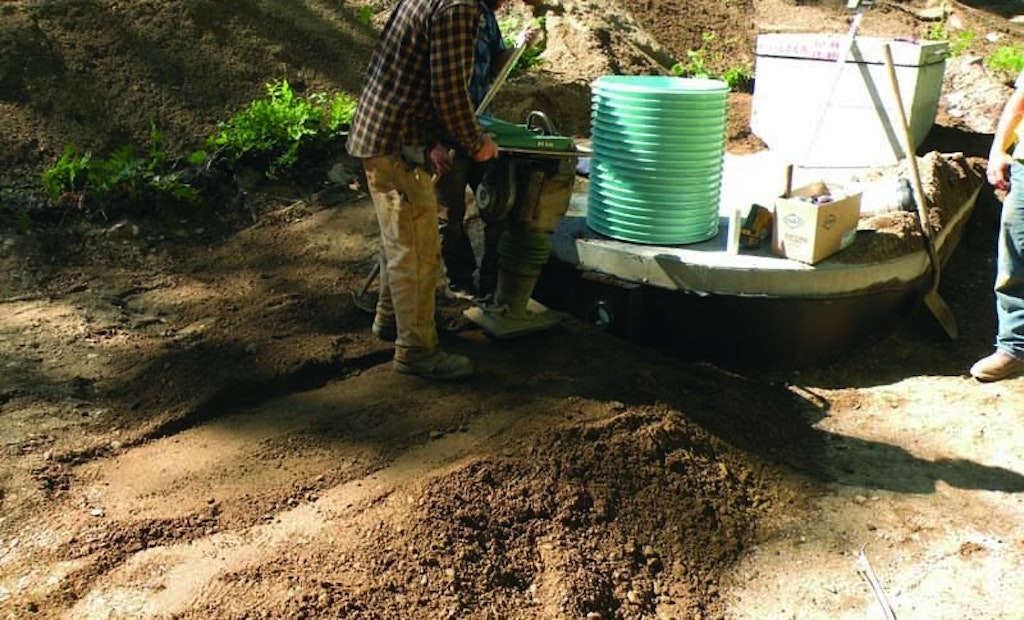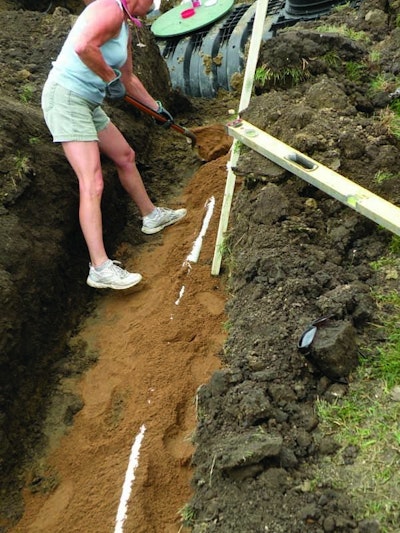
In cold weather areas like the Upper Midwest where we live, there are often situations where the piping and tanks need to be protected from freezing. For supply pipes from the house to the septic tank and the tank to the drainfield, the best protection from freezing is to install the pipes properly, on the correct slope and with proper bedding to eliminate differential settling. The key to remember: The only thing in the pipe between use discharges is air. If there is standing water because of a slight bow in the piping, this is an area that will be subject to freezing and plugging.
In municipal sewer systems, freezing is prevented by placing pipes below the normal frost depth, which can be as much as 6 to 8 feet deep. This does not work for our onsite systems that we want to keep as shallow as possible to provide the best treatment. If the piping is going to run under a driveway or walkway of any kind, it should be insulated. Any traffic over the area will drive the frost deeper, increasing the potential for freezing.
We have two methods for insulating pipe in this climate. The first is to purchase insulated pipe, usually a pipe within a pipe with foam insulation filling the void. The second is to install foam sheets rated for underground use over the top of the pipe as it is laid in the excavated trench. In addition to providing insulation, the first method will increase pipe rigidity, helping to prevent settling and low spots in the pipe where freezing could occur.
DEEP SOIL COVER
One of the most effective tactics to insulate any sewage tank is having at least 2 feet of soil cover over the tank with an established grass vegetation. However, with our emphasis on keeping systems shallow and providing ready access for operation and maintenance, we see an increasing need to insulate tanks to maintain temperatures that will allow active digestion of the wastewater to occur. This is true for septic tanks but is even more important for ATUs and media filters contained in tanks.
To address this issue in tanks sitting less than 2 feet below final grade, Minnesota requires the lid, maintenance hole covers and risers have an insulation value of R10. All insulating materials must be water-resistant and suitable for burial. Tank walls, lids and risers may be insulated.
To insulate the sides and the top of the tank, insulation board can be placed in those areas prior to backfilling. Flexible insulation board can be wrapped around the riser; if the riser is placed after the fact over a smaller tank opening, a piece of flexible insulation can be placed inside the riser above the smaller tank opening.
ADDED PROTECTION
As mentioned, the best insulation would be 2 feet of soil cover over the top of the tank. Many of our installers are still worried, though, because a typical bury depth to avoid frost would be 4 feet. This would force the system deeper and be counter to our objectives to keep the system as shallow as possible. So, they will generally insulate the tank lid with foam insulation to make sure the tank is protected. Most of the heat loss would be out of the top of the tank, so this gives an added measure of protection.
Some spray-on insulation products add to the R-value, but also provide additional sealant for seams that are coated. This is not a fix for bad installation practices or damage to tank access, however. The installer must use good materials and seal the seams and openings properly for an effective job. This means there must be no loose-fitting manholes, broken inspection pipes or unsealed conduit entering the tank that would allow cold air to enter.
Usage can also be a factor in determining whether a tank needs to be insulated. If it is at a seasonal residence where the system is not used during the winter, insulation can actually delay tank warm-up in the spring. Our thoughts are that these places often work toward year-round usage, so be cautious making that assumption. In general, if the top is 2 feet or more below grade, insulation over the tank is not necessary. But remember, the risers and riser lids do need insulation. If the depth is less than 2 feet, the tank should be insulated.






